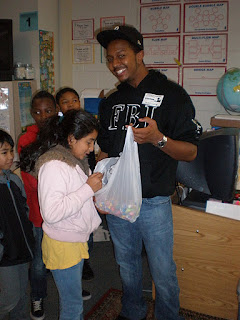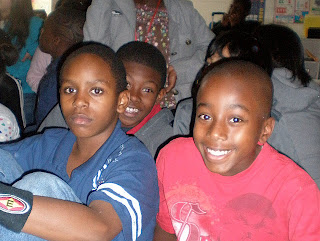After the excitement of the field trip, each group had a follow-up visit with their 5th grade classroom for a quiz bowl. Each group of undergraduates developed five Jeopardy! style questions about a relevant topic: ELISA, ecosystems, water pollution, and pesticides. Sample questions included “Antibodies are shaped like this letter” and “These samples help a scientist make sure an experiment is working properly.”
The undergraduates took turns posing questions to the 5th graders, and Bridget and Ms. Marian Kanipes ran the Powerpoint display of the game.
 |
| Charnell, Jacqui, Shaylon, and Julalak lead the game in Ms. Kanipes' classroom. |
 |
| Bridget runs the technology in Ms. Crutchfield's classroom. |
 |
| Fifth grade coordinator, Ms. Marian Kanipes, was a gracious collaborator who kept us on track! |
The students worked in teams with pairs of classrooms competing against each other. The students were impressive in their ability to work together in large groups! Each classroom had a spokesperson to relay their final answer to the A&T student leaders.
Every student received some candy at the end, and the winning teams received prizes donated by the Louis Stokes Minority Alliance Partnership (LSAMP) and Department of Energy and Environmental Systems at NCATSU.
 |
| Shaylon distributes candy to participants in Ms. Kanipes' classroom. |
This second classroom visit was an exciting and satisfying end to our project that also helped solidify the 5th graders’ learning. It was great to realize how much the students had learned about chemistry, pesticides, and the ELISA method. You can see more pictures from this classroom visit here.
I was able to return to Rankin for the 4th and 5th graders' science fair in December, and I am proud to have worked with these young scientists this semester. I want to close with a big thanks to my students, the Rankin staff and teachers, and the chemistry department at A&T for all their help making this project a success!
I was able to return to Rankin for the 4th and 5th graders' science fair in December, and I am proud to have worked with these young scientists this semester. I want to close with a big thanks to my students, the Rankin staff and teachers, and the chemistry department at A&T for all their help making this project a success!






























